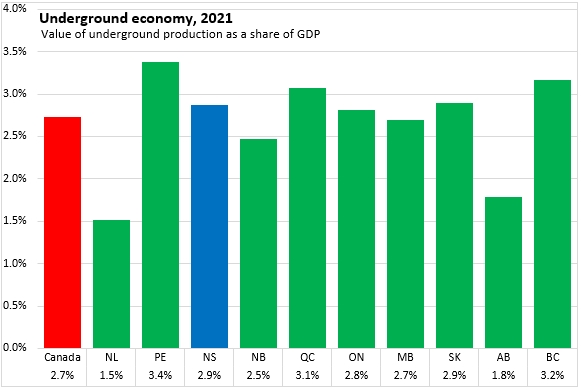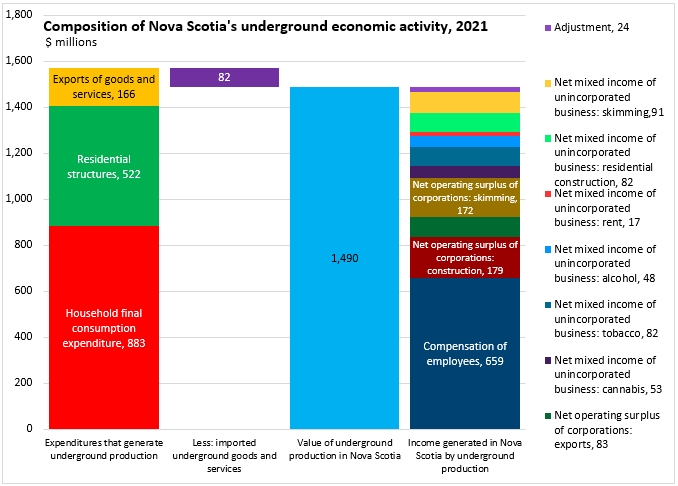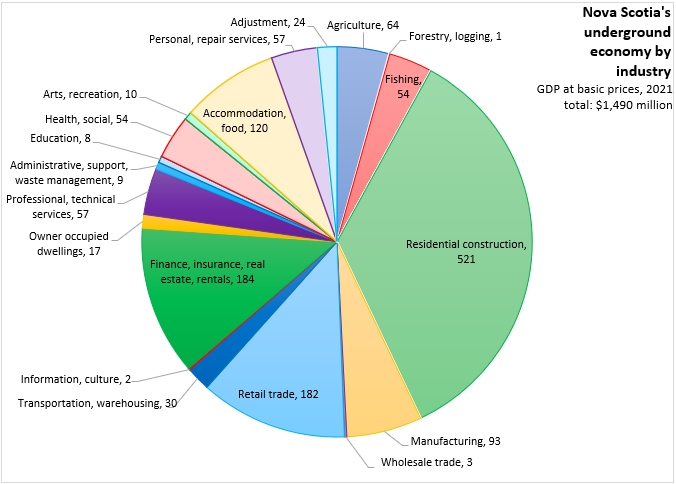The Economics and Statistics Division maintains archives of previous publications for accountability purposes, but makes no updates to keep these documents current with the latest data revisions from Statistics Canada. As a result, information in older documents may not be accurate. Please exercise caution when referring to older documents. For the latest information and historical data, please contact the individual listed to the right.
<--- Return to Archive
For additional information relating to this article, please contact:
February 22, 2023UNDERGROUND ECONOMY, 2021 Statistics Canada has updated its estimates for the value of the underground economy to the 2021 reference year. The underground economy is defined as “consisting of market-based activities, whether legal or illegal, that escape measurement because of their hidden, illegal or informal nature.”
In Nova Scotia, the underground economy is estimated to have amounted to 2.9% of provincial GDP in 2021, a total of $1.49 billion. Nova Scotia's underground economy as a share of GDP is higher than the national average of 2.7%. Underground economy as a share of GDP is highest in Prince Edward Island (3.4%) and lowest in Newfoundland and Labrador (1.5%).

Nova Scotia's underground economy has remained stable as a share of GDP since 2014, fluctuating between 2.8% and 2.9% of GDP over this period.
Expenditures by households generated the largest amounts of GDP from the underground economy. Consumptions expenditures of $883 million as well as investments in residential structures of $522 million contributed the most to Nova Scotia's underground economy. This was followed by $166 million in exports that generated underground activity. To arrive at the $1.49 billion estimate of total GDP in Nova Scotia's underground economy, Statistics Canada's subtracts the $82 million in imported products that were prompted by underground economic activity.
The largest amount of income generated as a result of Nova Scotia's $1.49 billion in underground economy GDP was employee compensation ($659 million), followed by net operating surplus of corporations ($434 million) and net mixed income of unincorporated businesses ($373 million). The largest contributors to business income generated by underground activities were construction ($179 million for incorporated businesses and $82 million for unincorporated businesses) and skimming ($172 million for incorporated businesses and $91 million for unincorporated businesses). Skimming refers to overstated expenses or other failures to declare business income.

In Nova Scotia, residential construction accounts for over one-third of estimated underground economy GDP.
The next largest contributors to Nova Scotia's underground economy were: finance/insurance/real estate/rentals, retail trade, accommodation/food services, manufacturing, agriculture, professional/technical services, personal/repair services, health care/social assistance and fishing.

Notes: Statistics Canada cautions that data on the underground economy are by definition unobserved and estimates are prepared using assumptions, indicative measures and indirect methods. The estimates presented represent an upper bound. Users should interpret the data carefully and should not add estimates of underground economy to conventionally-measured GDP.
Source: Statistics Canada. Table 36-10-0682-01 Underground economy, by expenditure-based gross domestic product component, current dollars; Table 36-10-0683-01 Underground economy, by income-based gross domestic product component, current dollars; Table 36-10-0684-01 Underground economy, by industry, current dollars; Methodology for measuring the underground economy by province and territory.
<--- Return to Archive